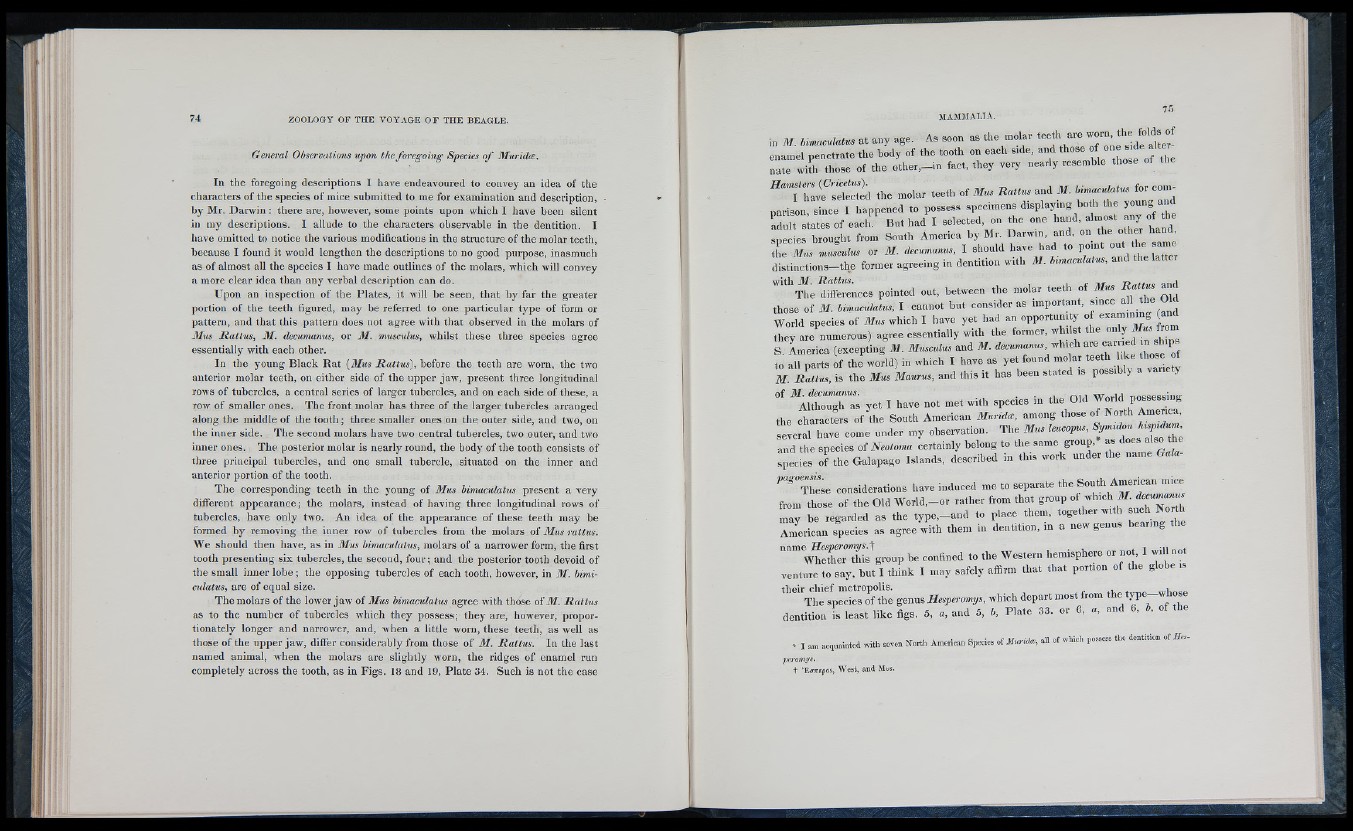
General Observations upon the foregoing Species of Muridoe.
In the foregoing descriptions I have endeavoured to convey an idea of the
characters of the species of mice submitted to me for examination and description, •
by Mr. Darwin : there are, however, some points upon which I have been silent
in my descriptions. I allude to the characters observable in the dentition. I
have omitted to notice the various modifications in the structure of the molar teeth,
because I found it would lengthen the descriptions to no good purpose, inasmuch
as of almost all the species I have made outlines of the molars, which will convey
a more clear idea than any verbal description can do.
Upon an inspection of the Plates, it will be seen, that by far the greater
portion of the teeth figured, may be referred to one particular type of form or
pattern, and that this pattern does not agree with that observed in the molars of
3Ius Rattus, 31. decumanus, or 31. musculus, whilst these three species agree
essentially with each other.
In the young Black Rat (3Ius Rattus), before the teeth are worn, the two
anterior molar teeth, on either side of the upper jaw, present three longitudinal
rows of tubercles, a central series of larger tubercles, and on each side of these, a
row of smaller ones. The front molar has three of the larger tubercles arranged
along the middle of the tooth ; three smaller ones on the outer side, and two, on
the inner side. The second molars have two central tubercles, two outer, and two
inner ones. The posterior molar is nearly round, the body of the tooth consists of
three principal tubercles, and one small tubercle, situated on the inner and
anterior portion of the tooth.
The corresponding teeth in the young of Mus bimaculatus present a very
different appearance; the molars, instead of having three longitudinal rows of
tubercles, have only two. An idea of the appearance of these teeth may be
formed by removing the inner row of tubercles from the molars oi' Mus rattus.
We should then have, as in 3Itis bimaculatus, molars of a narrower form, the first
tooth presenting six tubercles, the second, four; and the posterior tooth devoid of
the small inner lobe ; the opposing tubercles of each tooth, however, in M. bimi-
ailatus, are of equal size.
The molars of the lower jaw of Mus bimaculatus agree with those oî M. R attus
as to the number of tubercles which they possess; they are, however, proportionately
longer and narrower, and, when a little worn, these teeth, as well as
those of the upper jaw, differ considerably from those of 31. Rattus. In the last
named animal, when the molars are slightly worn, the ridges of enamel run
completely across the tooth, as in Figs. 18 and 19, Plate 34. Such is not the case
in M. Umaculatus at any age. As soon as the molat teeth are
enamel penetrate the body of the tooth on each side, and those »“ J f
nate with those of the oth er,-in fact, they very nearly resemble those
retecTed the molar teeth of Mus Rattus and M. bmacuhtus for com^
parison, since I happened to possess specimens displaying both the young and
Idult states of each. But had I selected, on the one hand, almost any of the
s , t l s b r o u lt from South America by Mr. Darwin, and, on the other hand,
the 3Ius musculus or 31. decumanus, I should have had to p en t « « y h e ^
distinctlons-the former agreeing in dentition with 31. bimaculatus, and the latter
'’‘^Th^e ffifferences pointed out, between the molar teeth of Mus Rattus and
those of M. bimaculatus, I cannot but consider as important. ^
World species of 3Ius which I have yet had an opportunity of examining (ani
l y are'numerous) agree essentially with the former, whilst the only ^ f m
S. America (excepting M. 3Iusculus and 31. which n si p.
to all parts of the world) in which I have as yet found molar
31. Rattus, is the Mus Maurus, and this it has been stated is possibly variety
“ “ yet I have not met with species in the Old World possessing
the characters of the South American Muridoe, among those of North America,
several have come under my obseiwation. The Mus Uucopus,
and the species of Neotoma certainly belong to the same group.* as does also the
species of the Galapago Islands, described in this work under the name Gala-
''““ ‘’T h te considerations have induced me to separate the South Amerman mice
from those of the Old W orld,-or rather from that group
may be regarded as the typ e,-an d to place them, together with such North
American species as agree with them in dentition, in a new genus bearing
w tX r T h is ^ r o u p be confined to the Western hemisphere or not, I wili not
venture to say, hut I think I may safely affirm that that portion of the globe is
T tr sp ” ffiiTf1he genus iiespcromys, w h i c h depart most from the type-w hose
dentition is least like figs. 5, a, and 5, 5, Plate 33. or 6, «. and 6, J. of the
. I »ra ncquaintcd . i t h seven N ortl. American Species ef MurUoe, all ot ,h ic h possess tl.e dentition of H « -
peromys.
t ’EffTrepoî, West, and Mvs.